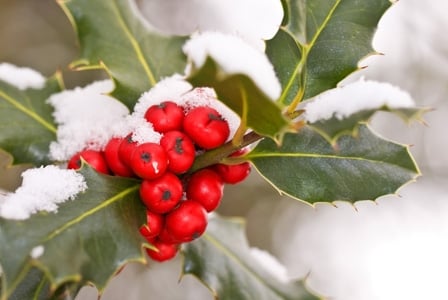
Thats right – on this Wildlife Wednesday, were learning about that plant whose boughs we used to deck the halls: holly.
We’ve seen the cards and heard (and sung) the carols about this prickly and pretty little plant, so let’s grow on our current horticultural knowledge and learn some holly facts that are sure to at least mildly entertain the in-laws.
That’s right—on this Wildlife Wednesday, we’re learning about that plant whose boughs we used to deck the halls: holly.
Habitat
In the wild, these hardy plants can be found producing those bright, red berries everywhere from blustery mountain sides to sandy beaches. Depending on the species, holly can be found anywhere in the world, with the exception of the Arctic and Antarctic regions (sorry, Santa!).
Trivia
- The type of holly that you’re probably most familiar with is American holly, also (and aptly) known as Christmas holly. When settlers first came to North America, the plants reminded them of the English holly from their homeland, and they promptly began using this new species for holiday decorations.
- American holly and English holly are just two of the 400 or so members of the holly family. Other species include Ilex paraguariensis, which is used to make the popular tea blend yerba maté.
- Most of these 400 species are shrubs and trees, but some types of holly are climbers, using trees and other stable structures for support, and others (called epiphytes) perch and grow on the branches and trunks of trees.
- Holly is generally dioecious, meaning that there are distinctly male or female plants and that both are needed for berry production. Plus, while males and females both produce flowers, only the female plants produce the lovely red berries we’re familiar with.
Should we really be decking halls?
Many of us enjoy a using a few decorative sprigs to spruce up our Christmas trees or as a festive centerpiece for our holiday dinners, and why shouldn’t we? Holly can be grown locally and can simply return to the soil when their life as a decoration is over.
If you toss your holly plant—and its vibrant berries—into your compost when you’re done with it, though, you may want to take note. English holly, which (as the name suggests) isn’t native to North America, is commonly sold during the holiday season to shoppers who prefer natural decorations to the plastic ones. It’s also a notorious invasive plant that has taken root along the west coast of Canada and the US.
Prevention is always the best solution. Before buying a holly plant this season, make sure that you know which species you’re buying. Ask your local nursery for more information about your potential new houseguest and be sure to do your own research.

